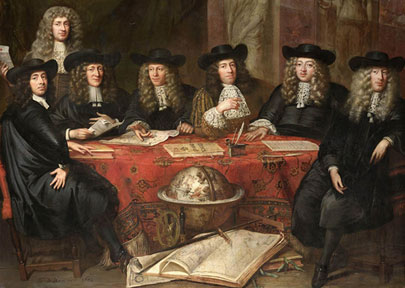|
 The
Dutch Reformed Church at Regent Street: The
Dutch Reformed Church at Regent Street:
100 years of celestial excellence
by Dishan Joseph
"Land ahoy! Five degrees on the Port bow," were the words uttered by
the Captain of the Dutch ship 'Le Brebis', reporting to Admiral Joris
Van Spilbergen, commander of three ships that defiantly sailed towards
our island and anchored at the port of Batticaloa on May 31, 1602. The
Portuguese had by now consolidated their presence with many fortified
cities namely Trincomalee, Negombo, Colombo and Galle.
On March 13, 1640, troops led by William Jacobsz Coster mounted a
successful attack on the Portuguese garrison at Galle. This triumphant
battle was very significant as the Dutch made Galle their capital for
the next 16 years. Motivated by victory, the Dutch soldiers once again
led a daring assault on the fortified city of Colombo in 1655. The
Portuguese put up a stiff resistance. Colombo was under siege for almost
seven months. In 1656 the weary Portuguese made a final retreat. Thus
the Dutch gained supreme control of all the maritime districts.
The island by this time had three major religious faiths namely
Buddhism, Hinduism - introduced by the Dravidian invasion of the 13th
century and Roman Catholicism. It was a daunting challenge for the Dutch
to impact the locals with their Reformed faith. As the years went by,
the number of adherents to the reformed faith grew, and churches were
built all over the island, including Jaffnapatnam (Jaffna). Some would
argue that this was due to political expedience rather than a personal
Christian conviction. The pioneer priests from Holland were supplemented
in ministry by Ceylonese Proponents, men who had undergone theological
training. It is interesting to note that it was during this period that
Fr. Joseph Vaz, from the Oratory of St. Philip Neri at Goa, came to
Ceylon, under disguise and won the goodwill of the Kandyan King and
continued to uphold the Catholic faith. Therefore it was in 1642 that
the Dutch Reformed Church was officially established at Point de Galle (Galle)
under the administration of Rev. Antonious Hornhovious. Majestic
edifices were built in Colombo, Galle and Jaffna. The Dutch focused in
propagating their faith primarily in the schools.
Dale of Wolves
In 1749 the Dutch constructed a colossal church at Wolvendaal
(presently the area known as Vivekananda Hill). It is believed that the
name derives from the old Portuguese 'Agoa de Loupe', meaning Dale of
Wolves, as there were such animals wandering about in the marsh lands
adjacent to the church, at night. Some argue that these were not wolves
but jackals from the areas adjacent to Kotahena.
During the period of 1850 the Pettah District, had become home to the
Dutch elite (a contrast to the crowded and noisy bazaar it is
today).Also during this period a Belfry was erected at Kaymans gate,
where it still stands today as a true enduring testament. As people
began to settle down here there was a sudden influx of citizens and they
had to be directed to Maradana and Dematagoda. Strangely this incident
would pave the way for the birth of two new churches. Rev. Lloyd Joseph,
a graduate of Princeton University, arrived in our island in 1908 and
contributed immensely to the progress of the church, at Maligakande. He
even started a Scout troop.
|

Board members of the Dutch East India Company |
As the congregation grew, in 1914, the Consistory was obliged to
purchase an acre of land at Regent Street, for a princely sum of Rs
35,000. They had intentions of relocating the church at Malgakande to
this new land. Work began on constructing the new church according to a
plan prepared by W. Claessen on December 1, 1914. It was built to
accommodate 350 people. The project cost for building, including
furniture and installation of electricity was Rs 33, 974. The following
year, the new church at Regent Street was ready for sacred worship on
December 22 (1915). The service of dedication was officiated by Rev. L.
A. Joseph, along with Rev. David Tweed, Rev. Francke and Rev. Fleming. A
Sunday Schools was begun on January 1, 1916.
Hope of a tree
During this time a pipe organ was installed in the church by Messers
Caves, and was used to glorify God with amazing melody until 1957.
Thereafter the organ was overhauled and installed at the church at
Magakande. There were many dedicated clergymen who put in herculean
effort to shepherd the flock at Regent Street during the early years
including Rev. Johan Van Ens, Rev. A.G.W. Foenander and Rev. R. V.
Metzeling. The Local Consistory was formed joining both the churches at
Regent Street and Malgakande. As the congregation grew rapidly they
realized the need for a day school and plans were made accordingly. In
1918 Presbyterian Girls School was formally declared open with Miss. H.
Ferdinands serving as Principal. Since then the school has educated
thousands of girls.
In the years that followed the Rev. Dunstan Thuring, Rev. Ananda
Perera, Rev. Reginald Ebenezer, Rev. Neville Koch, Rev. Charles N. Jansz
and late Rev. Roy Rebeira also left a lasting impression in sustaining
the missionary effort of their ardent forefathers. The Dutch churches in
Colombo have a Seal, with the inscription 'Spes est, Regerminat' which
is a reflection of the words of Job 14.7 from the Holy Bible "For there
is hope of a tree, if it be cut down, it will sprout again. It will not
cease". These inspiring words of scripture have indeed sustained the
Church at Regent Street for 100 years. It is hope, which regenerates and
enhances all human existence. |

